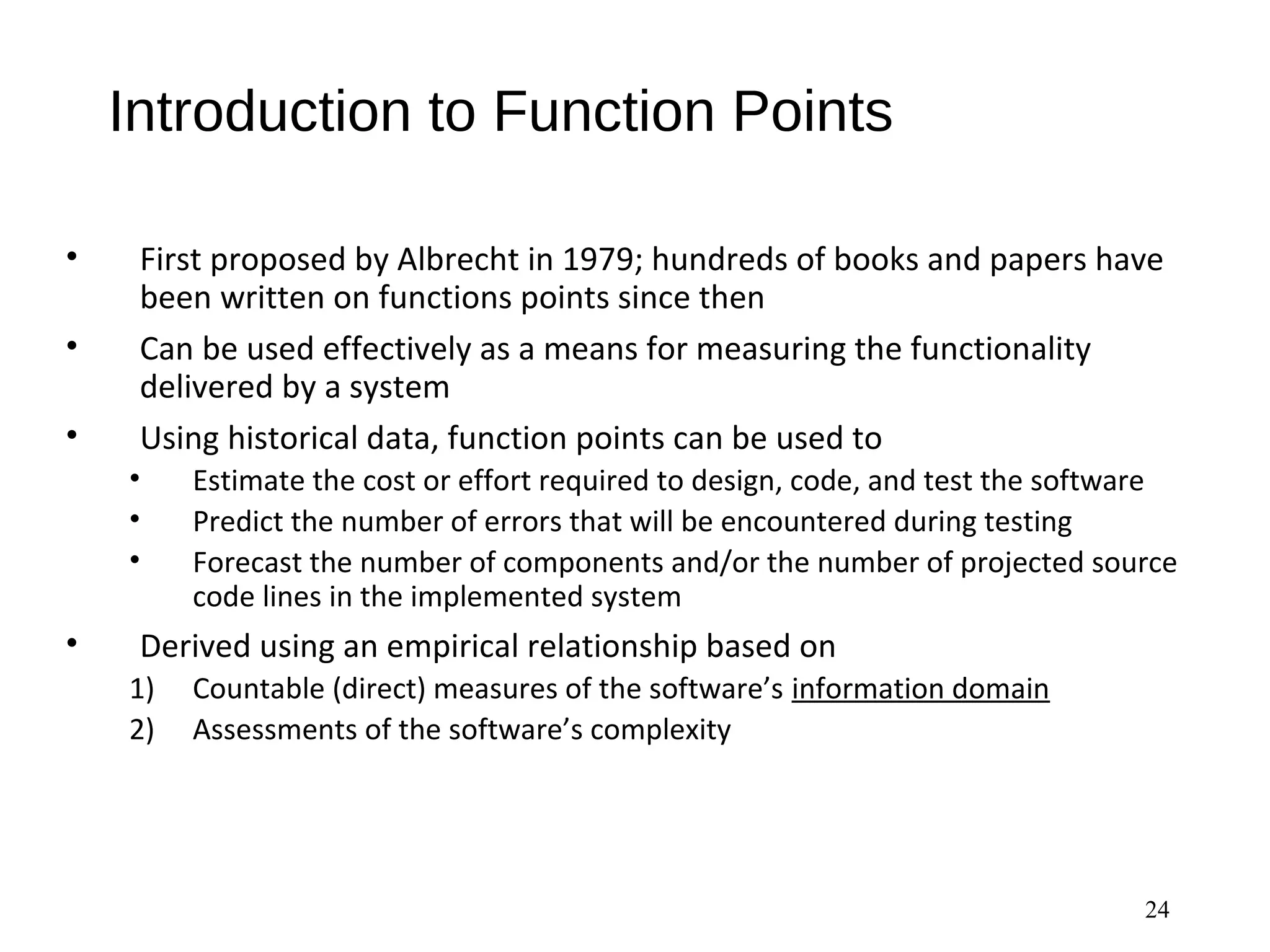Chapter 15 provides a comprehensive overview of software product metrics, covering their importance in assessing software quality and guiding development processes. It defines key software quality factors, introduces a taxonomy of metrics related to analysis, design, source code, and testing, and discusses methods for establishing, collecting, and analyzing these metrics. The chapter emphasizes the need for goal-oriented measurement techniques, such as the GQM paradigm, and highlights the characteristics of effective software metrics.


























![Function Point Computation
1) Identify/collect the information domain values
2) Complete the table shown below to get the count total
• Associate a weighting factor (i.e., complexity value) with each count based
on criteria established by the software development organization
1) Evaluate and sum up the adjustment factors (see the next two slides)
• “Fi” refers to 14 value adjustment factors, with each ranging in value from
0 (not important) to 5 (absolutely essential)
1) Compute the number of function points (FP)
FP = count total * [0.65 + 0.01 * sum(Fi)]
27
Information Weighting Factor
Domain Value Count Simple Average Complex
External Inputs _____ x 3 4 6 = _____
External Outputs _____ x 4 5 7 = _____
External Inquiries _____ x 3 4 6 = _____
Internal Logical Files _____ x 7 10 15 = _____
External Interface Files _____ x 5 7 10 = _____
Count total ________](https://image.slidesharecdn.com/ch-15-software-product-metrics-170706120947/75/Chapter-15-software-product-metrics-27-2048.jpg)


![Function Point Example
• FP = count total * [0.65 + 0.01 * sum(Fi)]
• FP = 50 * [0.65 + (0.01 * 46)]
• FP = 55.5 (rounded up to 56)
30
Information Weighting Factor
Domain Value Count Simple Average Complex
External Inputs 3 x 3 4 6 = 9
External Outputs 2 x 4 5 7 = 8
External Inquiries 2 x 3 4 6 = 6
Internal Logical Files 1 x 7 10 15 = 7
External Interface Files 4 x 5 7 10 = 20
Count total 50](https://image.slidesharecdn.com/ch-15-software-product-metrics-170706120947/75/Chapter-15-software-product-metrics-30-2048.jpg)



![Hierarchical Architecture Metrics
• Fan out: the number of modules immediately subordinate to the module i,
that is, the number of modules directly invoked by module i
• Structural complexity
• S(i) = f2
out(i), where fout(i) is the “fan out” of module i
• Data complexity
• D(i) = v(i)/[fout(i) + 1], where v(i) is the number of input and output
variables that are passed to and from module i
• System complexity
• C(i) = S(i) + D(i)
• As each of these complexity values increases, the overall architectural
complexity of the system also increases
• This leads to greater likelihood that the integration and testing effort will also
increase
34](https://image.slidesharecdn.com/ch-15-software-product-metrics-170706120947/75/Chapter-15-software-product-metrics-34-2048.jpg)





![Metrics for Maintenance
• Software maturity index (SMI)
• Provides an indication of the stability of a software product based on changes
that occur for each release
• SMI = [MT - (Fa + Fc + Fd)]/MT
where
MT = #modules in the current release
Fa = #modules in the current release that have been added
Fc = #modules in the current release that have been changed
Fd = #modules from the preceding release that were deleted in the
current release
• As the SMI (i.e., the fraction) approaches 1.0, the software product begins
to stabilize
• The average time to produce a release of a software product can be
correlated with the SMI
40
](https://image.slidesharecdn.com/ch-15-software-product-metrics-170706120947/75/Chapter-15-software-product-metrics-40-2048.jpg)